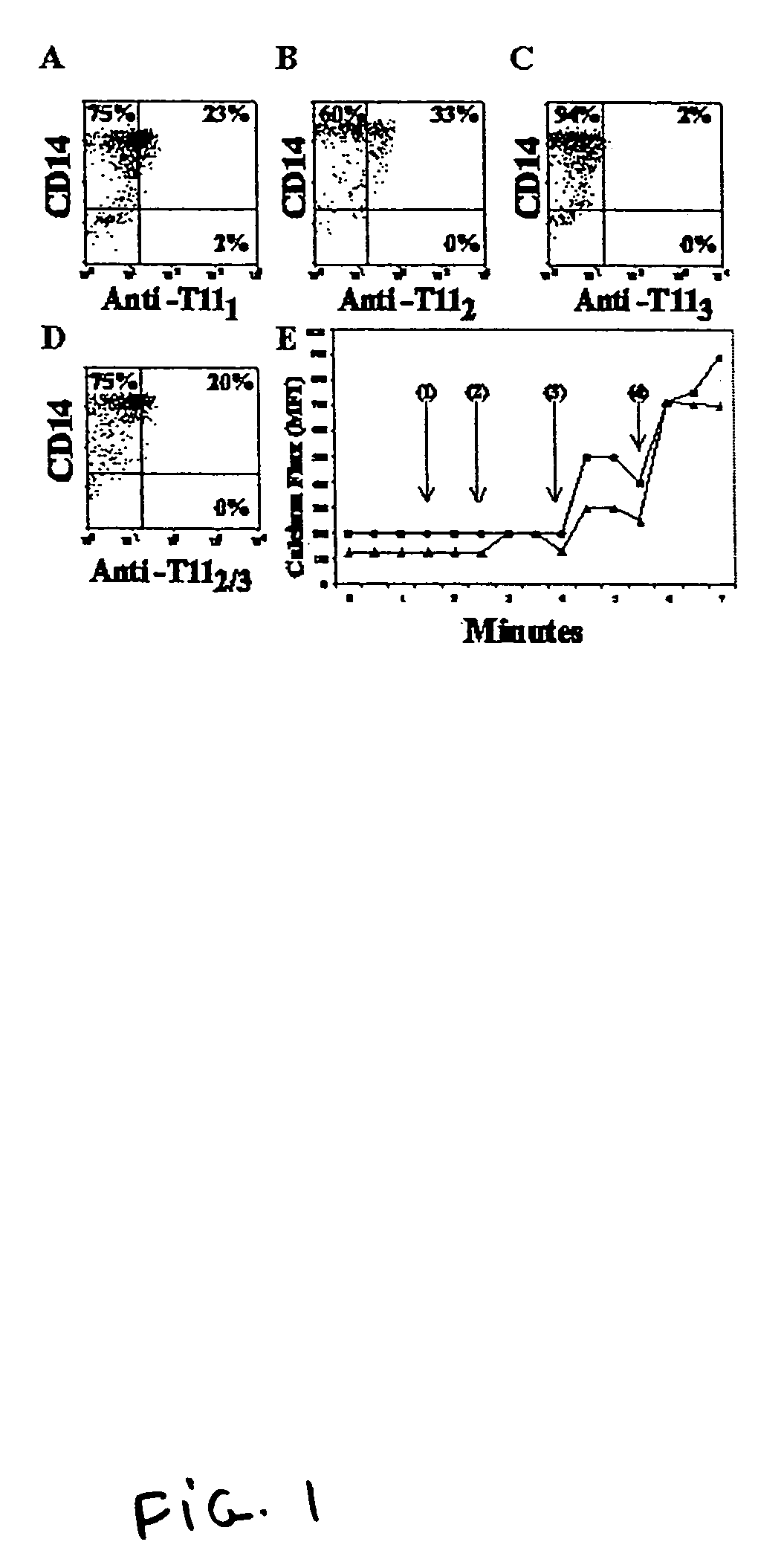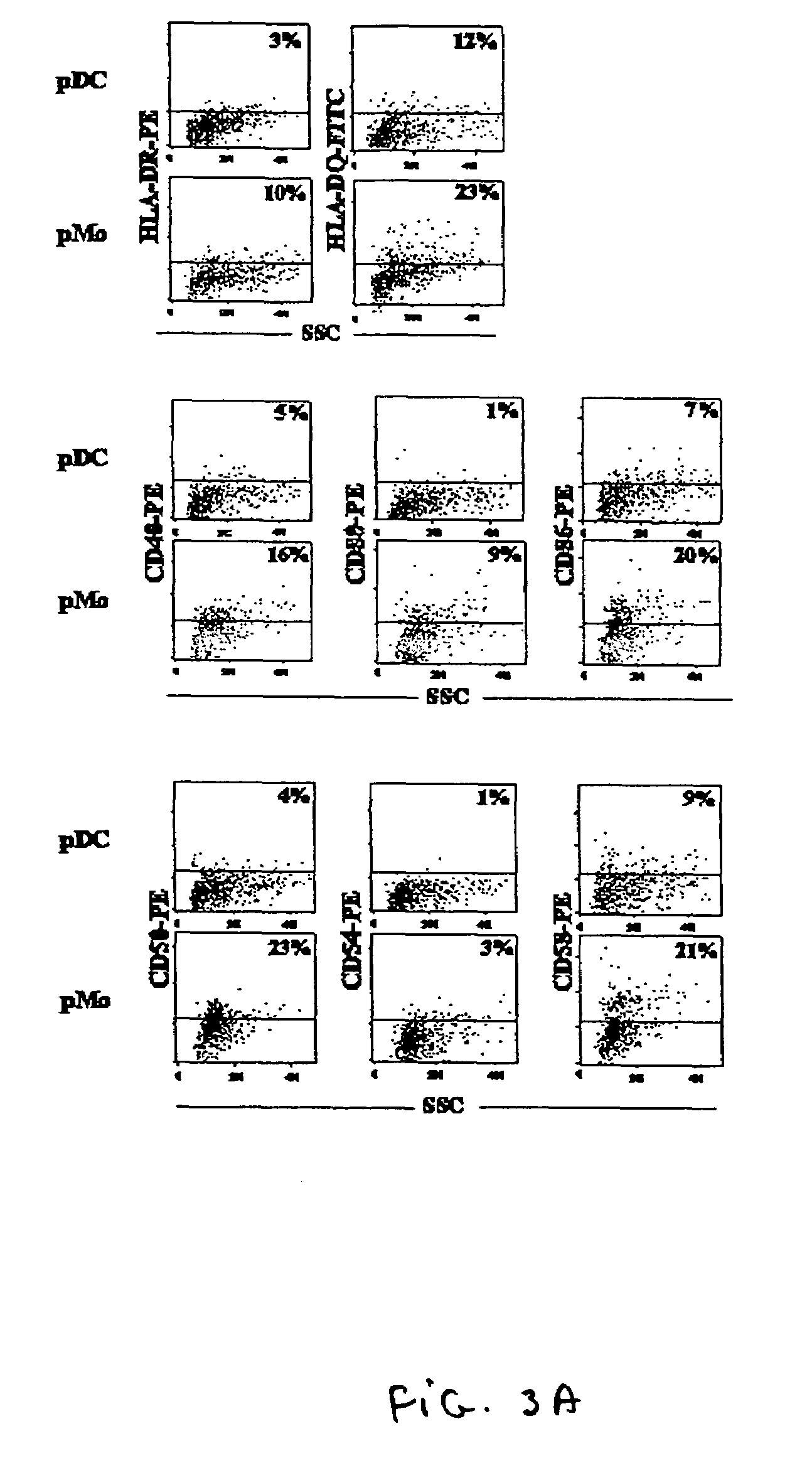Purification and uses of dendritic cells and monocytes
a technology of dendritic cells and monocytes, applied in the field of dendritic cell and monocyte purification, can solve the problems of low specificity, low sensitivity, difficult isolation of these cells, etc., and achieve the effect of stimulating host immunity, enhancing graft acceptance and monocyte suppression
- Summary
- Abstract
- Description
- Claims
- Application Information
AI Technical Summary
Benefits of technology
Problems solved by technology
Method used
Image
Examples
example 1
[0090]Isolation of Peripheral Blood Dendritic Cells and Monocytes.
[0091]This example illustrates the enrichment of monocyte and dendritic cell populations from human peripheral blood.
[0092](a) Selection (I) of Myeloid Cells
[0093]Leukocytes from a human peripheral blood sample were placed on a discontinuous Ficoll-gradient. Centrifugation separated the peripheral blood mononuclear cells (PBMCs) from the red blood cells. The PBMC population was suspended in a magnesium-free and calcium-free 2% Hanks' balanced salt solution (HBSS) at a concentration of 108 cells per ml. 20 pl of directly conjugated mouse anti-human magnetic beads (anti-CD3, anti-CD16, anti-CD19) (MACS superparamagnetic microbeads conjugated with monoclonal anti-human CD3, CD16 or CD19 antibodies, obtained from Miltenyi Biotec, Auburn, Calif.), was added so as to deplete the T cell, NK cell and B cell lymphocytes. This suspension was incubated for 30 minutes at 4° C. and was then passed through a magnetic column (obtain...
example 2
[0105]This example illustrates a variation for enrichment of monocyte and dendritic cell populations from human peripheral blood.
[0106]Prior to the lymphocyte depletion step (the Ficoll gradient step in Example 1 used to separate granulocytes and red blood cells from blood mononuclear cells (PBMC)), PBMCs were separated into two density populations by discontinuous gradient, metrizamide (Sigma Chemical Corp., St. Louis, Mo.) or one Step (Accurate Chemical and Scientific Corp., Westbury, N.Y.) centrifugation. This step separated the lymphocyte population (T cells, B cells, NK cells) from myeloid cells in bulk. The PBMCS, at a concentration of 107 cells per ml, were layered over 3 ml of 14.5% metrizamide in a 15 ml conical tube, or were layered over 12.5 ml of 14.5% metrizamide in a 50 ml conical tube. This cell suspension was spun at 1800 rpm for 10 minutes at room temperature. Two cell populations were evident by light scatter, i.e., the pelleted population which represented the hig...
example 3
[0108]This example illustrates another variation of the enrichment of monocyte and dendritic cell populations from human peripheral blood.
[0109]This method involves the direct enrichment of CD14+ myeloid cells from blood, thus eliminating the need to use a second discontinuous gradient, metrizamide, to separate lymphocytes from myeloid cells. This method is very efficient and eliminates the need to deplete contaminating lymphocytes in the myeloid population, because the red blood cells replace the magnetic beads, and lymphocyte or myeloid cell specific mAbs are attached to the red blood cells. These fractions were separated by ficoll and a Stem Cell Technologies (SCT) myeloid enrichment kit. This step separated the red blood cells and lymphocyte population (T-cells, B-cells and NK cells) together from myeloid cells (CD14+) in bulk. The SCT reagents are added to whole blood, at a concentration of 107 cells per ml, combined with a myeloid enrichment cocktail and layered over 12.5 ml o...
PUM
| Property | Measurement | Unit |
|---|---|---|
| magnetic field | aaaaa | aaaaa |
| temperature | aaaaa | aaaaa |
| final volume | aaaaa | aaaaa |
Abstract
Description
Claims
Application Information
 Login to View More
Login to View More - R&D
- Intellectual Property
- Life Sciences
- Materials
- Tech Scout
- Unparalleled Data Quality
- Higher Quality Content
- 60% Fewer Hallucinations
Browse by: Latest US Patents, China's latest patents, Technical Efficacy Thesaurus, Application Domain, Technology Topic, Popular Technical Reports.
© 2025 PatSnap. All rights reserved.Legal|Privacy policy|Modern Slavery Act Transparency Statement|Sitemap|About US| Contact US: help@patsnap.com



